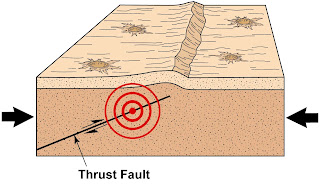As NASA continues to make progress toward sending astronauts to the lunar South Pole region with its Artemis campaign, data from a NASA-funded study is helping scientists better understand this strategic part of the Moon. The study presents evidence that moonquakes and faults generated as the Moon’s interior gradually cools and shrinks are also found near and within some of the areas the agency identified as candidate landing regions for Artemis III, the first Artemis mission planned to have a crewed lunar landing.
The epicenter of one of the strongest moonquakes recorded by the Apollo Passive Seismic Experiment was located in the lunar south polar region. However, the exact location of the epicenter could not be accurately determined. A cloud of possible locations (magenta dots and light blue polygon) of the strong shallow moonquake using a relocation algorithm specifically adapted for very sparse seismic networks are distributed near the pole. Blue boxes show locations of proposed Artemis III landing regions. Lobate thrust fault scarps are shown by small red lines. The cloud of epicenter locations encompasses a number of lobate scarps and many of the Artemis III landing regions. NASA/LROC/ASU/Smithsonian Institution
“Our modeling suggests that shallow moonquakes capable of producing strong
ground shaking in the south polar region are possible from slip events on
existing faults or the formation of new thrust faults,” said Tom Watters of the
Smithsonian Institution, Washington, lead author of a paper
on the research published January 25 in the Planetary Science Journal. “The global
distribution of young thrust faults, their potential to be active, and the
potential to form new thrust faults from ongoing global contraction should be
considered when planning the location and stability of permanent outposts on
the Moon.”
Lunar Reconnaissance Orbiter Camera (LROC), Narrow Angle Camera (NAC) mosaic of the Wiechert cluster of lobate scarps (left pointing arrows) near the lunar south pole. A thrust fault scarp cut across an approximately 1-kilometer (0.6-mile) diameter degraded crater (right pointing arrow). NASA/LRO/LROC/ASU/Smithsonian Institution
The Lunar Reconnaissance Orbiter Camera onboard NASA’s Lunar Reconnaissance Orbiter (LRO) has detected thousands of relatively small, young thrust faults widely
distributed in the lunar crust. The scarps are cliff-like landforms that resemble
small stair-steps on the lunar surface. They form where contractional forces
break the crust and push or thrust it on one side of the fault up and over the
other side. The contraction is caused by cooling of the Moon’s still-hot
interior and tidal forces exerted by Earth, resulting in global shrinking.
The lobate scarps are formed when the lunar crust is pushed together as the Moon contracts. This causes the near-surface materials to break forming a thrust fault. The thrust fault carries crustal materials up and sometimes over adjacent crustal materials. Slip events on existing faults or the formation of new thrust faults trigger shallow moonquakes that can cause strong seismic shaking tens of miles (many tens of kilometers) away from the scarp. Arizona State University/Smithsonian
The formation of the faults is accompanied by seismic activity in the form
of shallow-depth moonquakes. Such shallow moonquakes were recorded by the
Apollo Passive Seismic Network, a series of seismometers deployed by the Apollo
astronauts. The strongest recorded shallow moonquake had an epicenter in the
south-polar region. One young thrust-fault scarp, located within the de
Gerlache Rim 2, an Artemis III candidate landing region, is modeled in the study and shows that the formation
of this fault scarp could have been associated with a moonquake of the recorded
magnitude.
The team also modeled the stability
of surface slopes in the lunar south polar region and found that some areas are
susceptible to regolith landslides from even light seismic shaking, including
areas in some permanently shadowed regions. These areas are of interest due to
the resources that might be found there, such as ice.
Image shows predicted areas of surface slope instability in the south polar region. Models are for a one-meter-thick (about 3.3-foot) regolith landslide. Blue dots are areas with the least unstable slopes, green dots are moderately unstable slopes, and red dots are most unstable slopes. Image centered on Shackleton crater and the lunar south pole. Locations of proposed Artemis III landing regions are shown by the blue boxes. The model predicts large portions of the interior walls of Shackleton crater are suspectable to landslides (inset) as well as portions of interior crater walls in the Nobile Rim 1 landing region. NASA/LROC/ASU/Smithsonian Institution
“To better understand the seismic hazard posed to future human activities
on the Moon, we need new seismic data, not just at the South Pole, but
globally,” said Renee Weber, a co-author of the paper at NASA’s Marshall Space
Flight Center, Huntsville, Alabama. “Missions like the upcoming Farside Seismic Suite will expand upon measurements made during Apollo
and add to our knowledge of global seismicity.”
“LRO is committed to acquiring data
of the lunar surface to aid scientists in understanding important features such
as thrust faults,” said LRO Deputy Project Scientist Maria Banks of NASA’s
Goddard Space Flight Center in Greenbelt, Maryland, a co-author of the paper.
“This study is a good demonstration of one of the many ways in which LRO data
is being used to assist planning for our return to the Moon.”
This research was funded by NASA’s LRO mission, launched on June 18, 2009. LRO is managed by NASA Goddard for the Science Mission Directorate at NASA Headquarters in Washington. With Artemis missions, NASA is exploring the Moon for scientific discovery, technology advancement, and to learn how to live and work on another world as we prepare for human missions to Mars. We will collaborate with commercial and international partners and establish the first long-term presence on the Moon. NASA will land the first woman and first person of color on the Moon, using innovative technologies to explore more of the lunar surface than ever before.
Source: Shrinking Moon Causing Moonquakes and Faults Near Lunar South Pole - NASA




No comments:
Post a Comment